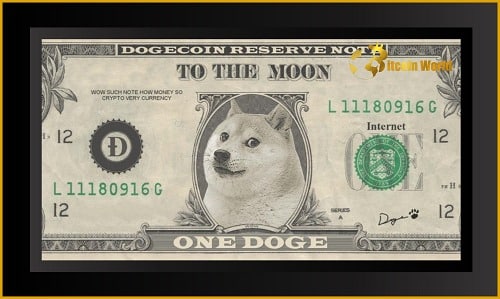Could Dogecoin, the meme-inspired cryptocurrency, actually become the future currency of the internet? Robinhood CEO Vladimir Tenev certainly thinks it’s possible! In a recent Twitter thread that got the crypto world buzzing, Tenev laid out his vision for how Dogecoin (DOGE) could evolve from a popular altcoin to a viable option for everyday online transactions. Let’s dive into what the ‘Doge Father’ had to say and explore the potential roadmap for DOGE to become the internet’s go-to digital cash.
Why Dogecoin as Internet Money? Tenev’s Perspective
Tenev kicked off his Twitterstorm by highlighting a key advantage Dogecoin already possesses: incredibly low transaction fees. At a mere $0.003 per transaction, DOGE is significantly cheaper than many traditional payment methods and even some other cryptocurrencies. This low-cost feature makes it inherently attractive for small, frequent online payments – the kind you’d make for your daily coffee, a digital subscription, or tipping your favorite online content creator.
But what’s holding Dogecoin back from widespread adoption? According to Tenev, two main factors need attention: block size and block time. These are crucial technical aspects that determine how quickly and efficiently a cryptocurrency network can process transactions.
Dogecoin’s Current Transaction Speed: Is it Fast Enough?
Currently, Dogecoin operates with a 1MB block size and a 1-minute block time. What does this mean in practical terms? It translates to a throughput of approximately 40 transactions per second (TPS). While 40 TPS might sound reasonable, let’s put it into perspective.
Consider VISA, the global payment processing giant. VISA boasts a throughput of over 65,000 TPS! To even approach VISA’s capacity, Dogecoin would need to increase its transaction processing power by a staggering 1,625 times. That’s a massive leap.
Is this an insurmountable obstacle? Tenev doesn’t think so. His proposed solution is surprisingly straightforward: increase the block size limit.
The Block Size Solution: Scaling Dogecoin for Mass Adoption
Tenev suggests a dramatic increase in Dogecoin’s block size. He proposes starting with an increase from the current 1MB to a whopping 1GB, and potentially even further to 10GB.
Think of it like this:
- Block size is like the size of a truck. A bigger truck (larger block size) can carry more packages (transactions) at once.
- Block time is like how often a truck departs. Shorter block time means trucks leave more frequently, processing transactions faster.
By significantly increasing the block size, Dogecoin could theoretically handle a much larger volume of transactions, bringing it closer to the speed and capacity required to function as a global internet currency.
Tenev concluded his thread with a direct call to action for the Dogecoin developers, urging them to prioritize expanding the block size limit. His message is clear: this is the key to unlocking Dogecoin’s potential as a truly useful digital currency.
Dogecoin’s Inventor Weighs In (On a Different Topic)
Interestingly, Tenev’s optimistic vision for Dogecoin came just hours after Dogecoin co-creator Jackson Palmer shared his thoughts on a completely different, but equally relevant, topic: Elon Musk’s potential acquisition of Twitter.
Palmer, known for his critical stance on centralized power and wealth, expressed skepticism about Musk’s move, stating:
“It takes some pretty incredible mental gymnastics to associate any type of ‘freedom’ with the world’s richest man attempting a hostile takeover and forcing one of the largest public social media platforms private.”
Palmer’s past criticisms of Musk, including calling him a “self-absorbed grifter,” are well-documented. While Palmer’s comments aren’t directly related to Dogecoin’s technical capabilities, they do touch upon the broader themes of decentralization and control within the cryptocurrency and tech space – themes that are often intertwined with the Dogecoin community’s ethos.
Dogecoin Price Remains Steady Amidst the Buzz
Despite the discussions sparked by Tenev’s tweets and Palmer’s commentary, the price of Dogecoin has remained relatively stable, trading in the $0.14 to $0.15 range for the past week. This suggests that while these developments are interesting for the Dogecoin community and crypto enthusiasts, they haven’t yet triggered significant market volatility.
The Road Ahead for Dogecoin: Internet Currency or Still a Meme?
Vladimir Tenev’s vision presents an intriguing path for Dogecoin’s evolution. By focusing on increasing transaction speed and capacity, he argues that DOGE can move beyond its meme origins and become a genuinely useful digital currency for the internet age. Whether the Dogecoin developers will heed his call to prioritize block size expansion remains to be seen.
Key Takeaways from Tenev’s Vision:
- Low Transaction Fees: Dogecoin already has a significant advantage for microtransactions.
- Block Size is the Key: Increasing block size is crucial for scaling transaction throughput.
- VISA Comparison: Highlights the immense scale of transaction processing needed for global adoption.
- Developer Action Needed: Tenev urges Dogecoin developers to prioritize block size upgrades.
The conversation around Dogecoin’s utility is far from over. Tenev’s perspective adds a new dimension to the narrative, suggesting a concrete path for DOGE to become more than just a meme. Will Dogecoin become the internet’s currency? Only time, and the actions of its developers and community, will tell.
Related Posts – Ferrari joins the NFT universe through a collaboration with a Swiss…
Disclaimer: The information provided is not trading advice, Bitcoinworld.co.in holds no liability for any investments made based on the information provided on this page. We strongly recommend independent research and/or consultation with a qualified professional before making any investment decisions.


